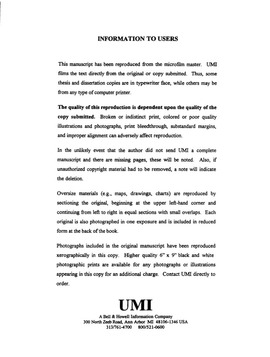| dc.contributor.advisor | Patten, William N., | en_US |
| dc.contributor.author | Li, Guangjun. | en_US |
| dc.date.accessioned | 2013-08-16T12:30:00Z | |
| dc.date.available | 2013-08-16T12:30:00Z | |
| dc.date.issued | 1998 | en_US |
| dc.identifier.uri | https://hdl.handle.net/11244/5628 | |
| dc.description.abstract | The purpose of this dissertation is to develop a systematic methodology for semiactive control systems to suppress the stress of highway bridges induced by heavy truck traffic. A program of research has been conducted by the Center for Structural Control (CSC) at the University of Oklahoma to extend the service life of highway bridges, by retrofitting them with computer-controlled hydraulic semiactive actuators. The dissertation explores two major complimentary research areas: (1) the intelligent stiffener for bridges (ISB) and (2) the second is intelligent vehicle/bridge system (IVBS). | en_US |
| dc.description.abstract | The application of reduced order model and modal modification techniques for dynamic analysis and semiactive control design is initiated in this dissertation. A 225 DOF bridge model which has been experimentally verified is used in the dynamic analysis and control system design. The bridge/vehicle coupled nonautonomous model is presented to investigate the dynamic characteristics of highway bridges in Chapter Three. The effect of several different parameters which significantly affect bridge dynamics are studied via simulation. Experimental data are provided to verify the simulation results. A practical control model which combined bridge dynamic equations and the coupled nonlinear hydraulic actuator dynamics is derived in Chapter Four. An Lyapunov bistate controller design for the ISB system is presented. The expected performance of the system is examined via simulation (deflection and moment). The trade-off design which is used to select a final configuration of the ISB assembly is also addressed in this chapter. The sufficient stability criterion for the nonautonomous bridge/vehicle perturbed system is next presented and the robustness of proposed Lyapunov semiactive controller is investigated in Chapter Five. Experimental results are presented in Chapter Six, and a description of the control hardware is also included. Chapter Seven provides the results of a preliminary effort to explore the feasibility of an intelligent vehicle/bridge system (IVBS). The performance of the IVBS is examined via numerical simulation. The last chapter (eight) offers conclusions and makes recommendations for future work. | en_US |
| dc.description.abstract | The dissertation describes a full scale design and implementation of an ISB system on a 122 m (400$\sp\prime)$ four-spans highway bridge. An Lyapunov analysis is used to synthesize a control law. Simulations, using variable bridge models, demonstrate the advantages of the new technology. The results indicate that the ISB system can reduce maximum deflections by as much as 60%; thus, adding many years of additional service life to the bridge. The expected performance of the ISB control system is also demonstrated by a full scale control experiment on an in-service interstate bridge. The results appear promising. Finally, the analytical studies on an alternative bridge vibration suppression system (IVBS) are presented. | en_US |
| dc.format.extent | xviii, 181 leaves : | en_US |
| dc.subject | Smart structures. | en_US |
| dc.subject | Intelligent control systems. | en_US |
| dc.subject | Engineering, Mechanical. | en_US |
| dc.subject | Engineering, Civil. | en_US |
| dc.subject | Bridges Design and construction. | en_US |
| dc.title | ISB and IVBS semiactive control of dynamic response for highway bridges. | en_US |
| dc.type | Thesis | en_US |
| dc.thesis.degree | Ph.D. | en_US |
| dc.thesis.degreeDiscipline | School of Aerospace and Mechanical Engineering | en_US |
| dc.note | Adviser: William N. Patten. | en_US |
| dc.note | Source: Dissertation Abstracts International, Volume: 59-04, Section: B, page: 1813. | en_US |
| ou.identifier | (UMI)AAI9828781 | en_US |
| ou.group | College of Engineering::School of Aerospace and Mechanical Engineering | |
